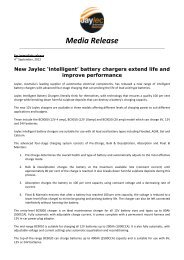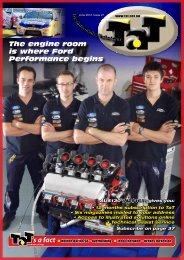What really does cause induction contamination? - TAT - The ...
What really does cause induction contamination? - TAT - The ...
What really does cause induction contamination? - TAT - The ...
Create successful ePaper yourself
Turn your PDF publications into a flip-book with our unique Google optimized e-Paper software.
Induction is the stage of the<br />
working cycle of an engine<br />
in which the fuel and air is<br />
drawn into the cylinders.<br />
Contamination means to<br />
make impure by exposure<br />
to or addition of a polluting<br />
substance.<br />
Induction <strong>contamination</strong> means<br />
any change from the original state<br />
of the complete intake system, fuel<br />
or air, of a vehicle. <strong>The</strong> air intake<br />
system includes the air filter box, air filter,<br />
air intake hoses, throttle body or butterfly<br />
unit, inlet manifold, engine valves and even<br />
the cylinder bores.<br />
<strong>The</strong> incidence of vehicles losing power<br />
and performance be<strong>cause</strong> of some form of<br />
<strong>induction</strong> restriction is increasing greatly.<br />
TaT sees evidence of this problem through<br />
the increasing numbers of TaT assist<br />
requests. Some of the pictures showing<br />
serious build-up of carbon have come<br />
from TaT workshops and others from our<br />
subscribers.<br />
It raises the<br />
question – what’s<br />
changed?<br />
And what do the aftermarket workshops<br />
need to know? Is there a need for some<br />
education of the motoring public? Can the<br />
<strong>contamination</strong> trend be slowed or reversed<br />
through some preventative measures?<br />
Many things are blamed for the build-up of<br />
carbon in inlet manifolds – poor fuel quality,<br />
poor or incorrect engine oil, engine design<br />
and even driving styles.<br />
Sometimes technology generates new<br />
problems. Is the build-up of carbon in the<br />
intake system one of them?<br />
Take the inlet manifold, for example. Once,<br />
there was a carburetor sitting on top of<br />
the engine. Fuel was delivered above the<br />
throttle plates, which were awash in petrol,<br />
one of the world’s great solvents.<br />
So carbon could not build up be<strong>cause</strong> of<br />
the washing action of swirling, fuel laden<br />
air.<br />
It’s fairly common now to find vehicles<br />
with very dirty inlet manifolds and throttle<br />
bodies bad enough<br />
to <strong>cause</strong> some<br />
<strong>The</strong> Automotive Technician 4<br />
<strong>The</strong> next<br />
plague…<br />
INDUCTION<br />
CONTAMINATION<br />
by Jeff Smit<br />
components to stick and fail. Customers<br />
complain of a loss of power or poor fuel<br />
economy.<br />
Vehicles began suffering from <strong>induction</strong><br />
<strong>contamination</strong> with the introduction of the<br />
first electronic fuel injection (EFI) systems.<br />
While these systems bring many benefits,<br />
including improved performance, fuel<br />
economy and lower emission output, they<br />
are subject to intake and throttle bore<br />
<strong>contamination</strong> problems. Once fuel was<br />
stopped from passing through the throttle<br />
bore, contaminants began to build up.<br />
Eventually, those carbon deposits must be<br />
removed to restore engine performance.<br />
Strict environmental controls, Euro 4<br />
emissions standards, and consumer<br />
demands for better fuel economy and<br />
performance forced design engineers to<br />
develop direct injection systems for both<br />
petrol and diesel engines. <strong>The</strong>se systems<br />
took the introduction of the fuel away from<br />
the inlet manifold altogether.<br />
So yet again the introduction of new and<br />
supposedly better systems has by their<br />
very design <strong>cause</strong>d a spin-off problem.<br />
<strong>The</strong>re appears to be no single reason for<br />
a build-up of contaminants in the intake<br />
systems, and it seems some makes and<br />
models suffer more than others.<br />
Source of<br />
<strong>contamination</strong><br />
Carbon build-up around the throttle body,<br />
throttle bore and inlet manifold restricts<br />
the airflow into the engine cylinders.<br />
Such an obstruction will result in a poor<br />
idle, a stalling condition and a drop in<br />
performance and fuel economy. <strong>The</strong><br />
most common source of<br />
these deposits is from the<br />
combustion and crankcase<br />
gases.<br />
<strong>The</strong> combination of the<br />
gases from the positive<br />
crankcase ventilation (PCV)<br />
system and from the exhaust<br />
gas recirculation (EGR) system<br />
will, in most cases, <strong>cause</strong> the<br />
intake <strong>contamination</strong>, more so when<br />
the PCV and the EGR points are<br />
positioned near the throttle<br />
plate. <strong>The</strong> EGR gases mix<br />
with the gases from the PCV<br />
system to form the gummy or<br />
waxy residue.<br />
<strong>The</strong> piston strokes and the<br />
negative to positive pressure<br />
pulsations direct the gases<br />
towards the throttle body,<br />
where they are baked on due<br />
to the intense heat. Foreign and<br />
domestic vehicles suffer equally.<br />
Engine PCV system<br />
<strong>The</strong> vapours that end up in an engine’s<br />
crankcase contain moisture as well as<br />
combustion by-products and unburned<br />
fuel vapours. <strong>The</strong> crankcase is sealed to<br />
prevent the escape of these gases into<br />
the atmosphere, but the vapours must<br />
be removed to prevent oil <strong>contamination</strong><br />
that leads to sludge formation. <strong>The</strong> PCV<br />
system siphons these vapours from the<br />
crankcase and routes them into the intake<br />
manifold so they can be reburned in the<br />
engine.<br />
<strong>The</strong> main component in the PCV system is<br />
the PCV valve, which is usually located in<br />
the valve cover. A hose connects the PCV<br />
valve to the intake manifold.<br />
<strong>The</strong> PCV valve is spring-loaded with a<br />
specific orifice size designed to restrict the<br />
amount of air siphoned from the crankcase<br />
into the intake manifold. This is necessary<br />
be<strong>cause</strong> air drawn through the valve from<br />
the crankcase has a leaning effect on the<br />
fuel mixture, much the same as a vacuum<br />
leak. So airflow through the valve must<br />
be controlled within certain limits. At idle,<br />
air flow is reduced be<strong>cause</strong> little blow-by<br />
is produced. When the engine is cruising<br />
and vacuum is high, airflow through the<br />
PCV valve is at a maximum to purge the<br />
vapours from the crankcase.<br />
EGR system<br />
A chemistry lesson on NOx first.<br />
<strong>The</strong> ‘x’ in NOx stands for the various<br />
oxides of nitrogen that are created. Among<br />
them are: NO (nitric oxide), a colorless,<br />
poisonous gas; NO 2<br />
(nitrogen dioxide)<br />
which is a reddish brown, toxic gas; and<br />
N 2<br />
O (nitrous oxide) which is commonly<br />
known as laughing gas.<br />
Environmental imperatives will demand<br />
continuing control of nitrogen oxide<br />
emissions. Most of the carbon monoxide<br />
and almost 50 per cent of the nitrogen<br />
oxides and hydrocarbons come from<br />
burning petrol and diesel fuels in cars and<br />
trucks. Nitrogen oxides are only created at<br />
very high temperatures and pressures, as<br />
found in automotive engines.<br />
Basic EGR operation<br />
NOx forms under high pressures and<br />
temperatures found in the combustion<br />
chamber, so it can be controlled by
















